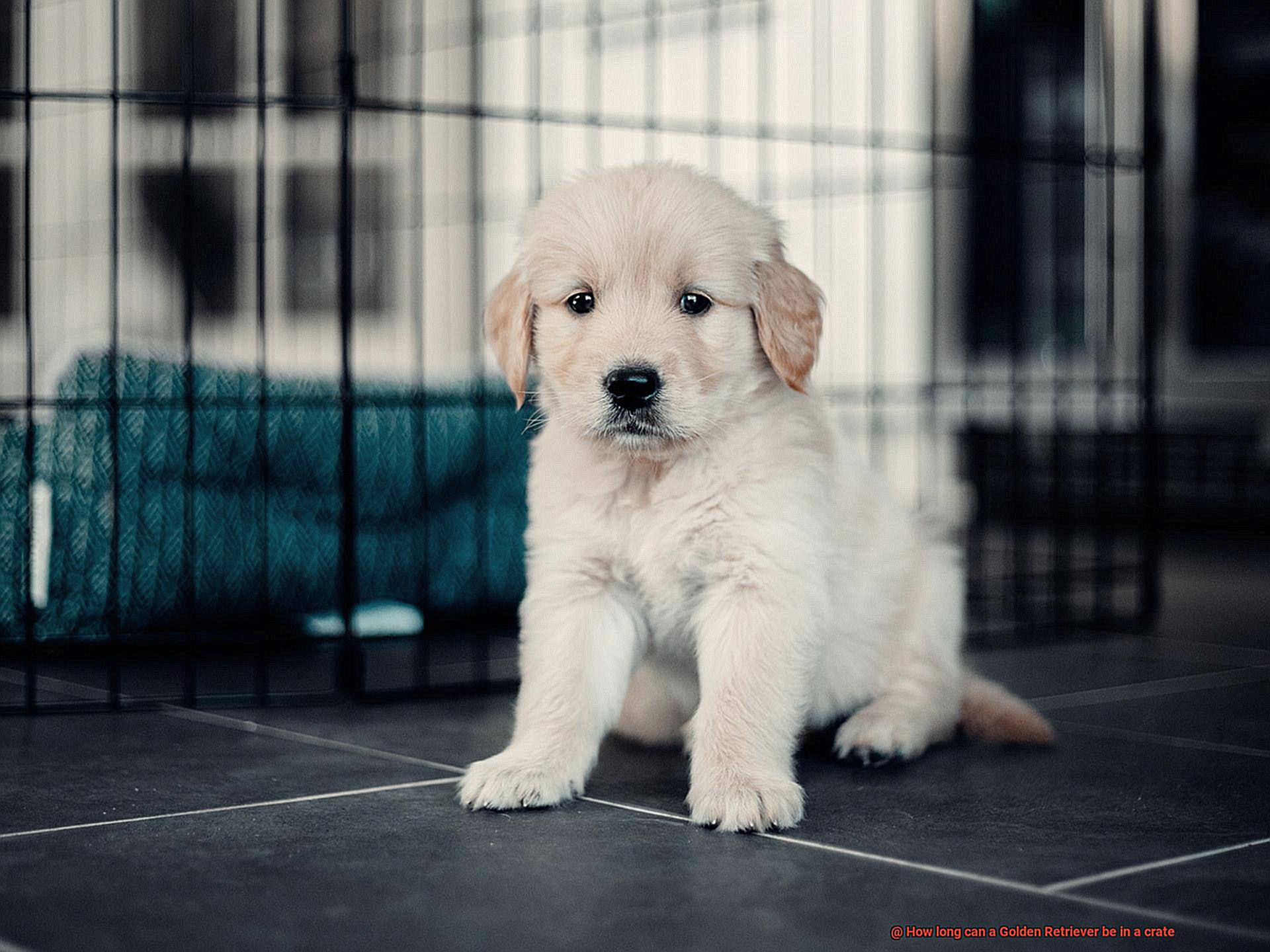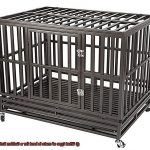Are you a proud owner of a Golden Retriever, or are you considering getting one? These lovable dogs are known for their loyalty, friendly demeanor, and intelligence. However, as a pet parent, you may be wondering how long your furry friend can safely stay in a crate.
The topic of crating your pup can be a sensitive one. After all, we want our pets to feel comfortable and secure at all times. But there are practical reasons for crating your Golden Retriever too – like during travel, potty training, or when running errands.
So, how long can a Golden Retriever stay in a crate? The answer isn’t straightforward since it depends on various factors such as age, breed, and size. But don’t worry. In this blog post, we’ll dive deep into these factors to bring you some much-needed clarity on this topic.
We’ll also explore how to create a safe and cozy environment for your furry friend inside the crate. Plus, we’ll discuss the importance of exercise and socialization outside of the crate and how to establish a routine that works best for both you and your pup.
By the end of this post, you’ll have a better understanding of how long your Golden Retriever can stay in their crate without compromising their well-being. So let’s get started.
What Is Crating?
Contents
Crating, the practice of keeping your dog in a crate or kennel when they are not under direct supervision, can be an effective tool for achieving these goals.
Crates come in different materials and sizes to accommodate various breeds of dogs. They can be made of plastic, metal, or fabric, and should always provide enough space for your dog to move around comfortably. When used properly, crates can provide your dog with a sense of security and help manage their behavior in a positive way.
Crating can be beneficial for a variety of reasons. It can help prevent destructive behavior, aid in house training, and provide a safe and secure space for your dog when you are away from home. However, it’s essential to remember that crating should never be used as punishment or confinement for extended periods of time.
For Golden Retrievers, the general rule of thumb is that they can safely remain in their crate for no more than 4-6 hours at a time. Puppies under 6 months may need to be let out more frequently as their bladders are not yet fully developed. It’s crucial to make sure your dog has enough space to move around comfortably and access to water.
To ensure your dog has a positive experience while crated, it’s important to gradually increase the amount of time they spend in the crate and make it a comfortable space for them. Providing treats and toys while inside can help make the experience more enjoyable.
The General Rule of Thumb for How Long a Golden Retriever Can Be in a Crate
The general guideline is no more than 8 hours per day. But there are several factors that can affect this time frame.
One of the most critical factors to consider is your Golden Retriever’s age. Puppies need more frequent breaks and should only be crated for 2-3 hours at a time. Adult dogs, on the other hand, can hold their bladders for longer periods and may be able to stay in a crate for up to 8 hours. However, keep in mind that every dog is unique, and some may require more frequent potty breaks.
Another factor to consider is the size of your Golden Retriever’s crate. A crate that’s too small can cause discomfort and anxiety, while one that’s too big can lead to accidents and make it challenging for your dog to feel secure. Your Golden Retriever should be able to stand up, turn around, and lay down comfortably in their crate.
Lastly, providing your furry friend with enough exercise and mental stimulation outside of their crate is crucial. A tired and mentally stimulated dog is more likely to relax and feel comfortable in their crate. Conversely, a bored or anxious dog may become restless or destructive.

Remember that these factors are just guidelines, and you should adjust the amount of time your Golden Retriever spends in a crate according to their individual needs. Gradually increase the time spent in the crate, make it comfortable with treats and toys, and always ensure they have enough space and water.

Considerations for Puppies Under 6 Months of Age
When it comes to crate training, it’s important to consider the unique needs of puppies under 6 months of age.
First and foremost, puppies have small bladders and may not be able to hold their urine for extended periods. To avoid accidents and discomfort, remember that puppies under 6 months should not be left in a crate for more than 3-4 hours at a time. If you plan on being away from home for longer periods, arrange for someone to take your pup out for potty breaks.
But beyond bladder control, it’s crucial to prioritize your puppy’s socialization and exercise needs. Puppies thrive on interaction with their owners and playtime with other dogs and people. Being cooped up in a crate can lead to anxiety and behavioral issues later in life. So make sure you give your pup plenty of opportunities to explore and socialize.
When it comes to crate training, make the crate a comfortable and positive space. Soft bedding, toys, and treats will help your pup feel at home. Gradually increase the amount of time your puppy spends in the crate, but never use it as a form of punishment.
Ensuring Access to Water
Dehydration can have serious consequences for dogs, especially if they’re crated for an extended period of time. Luckily, there are several ways you can ensure your furry friend stays hydrated and healthy.
One option is a crate-mounted water bottle. These bottles attach to the side of the crate and allow your dog to drink from a convenient spout without the risk of knocking over a bowl of water. It’s important to ensure the bottle is securely attached to the crate and that your dog knows how to use it before leaving them alone.
Alternatively, you can place a bowl of water inside the crate. However, this can be tricky as Golden Retrievers are known to be enthusiastic drinkers who may spill or knock over their bowl. To prevent this, you can use a heavy, non-spill bowl or attach a bowl to the side of the crate. Remember to keep an eye on their water intake and refill the bowl as needed.
It’s crucial to consider how long your Golden Retriever will be crated. If you plan on crating them for extended periods, it’s essential to provide access to water at all times. If you’re unable to do so, arrange for someone to check on your dog and provide them with water throughout the day. Ensuring access to water is essential for their health and well-being.
Remember, your Golden Retriever’s crate should be a safe and comfortable space, not a form of punishment. By providing them with access to water while in their crate, you’re helping them feel secure and relaxed while ensuring they stay healthy and hydrated.
Providing Enough Space in the Crate
That’s why choosing the right crate size is essential to their well-being. A cramped space can cause discomfort and stress, which can make your furry friend reluctant to spend time in it.
So, what is the ideal crate size for your Golden Retriever? The general rule of thumb is to choose a crate that is at least as long as their body and tall enough for them to stand up without touching the top. The width should also allow them to move around freely. If you have a puppy, consider their future size when selecting a crate.
Providing enough space in the crate is not only about physical comfort; it’s also about their mental well-being. Dogs are social animals and need interaction with their human family and other dogs. If they are confined to a small space for extended periods, it can lead to anxiety and behavior problems.
But don’t worry; you can make the crate more inviting and cozy by adding soft bedding. Ensure that it’s safe for your dog and won’t pose a choking hazard if they decide to chew on it.
Remember that crating should not be a long-term solution for confinement. Your Golden Retriever needs plenty of exercise and socialization outside of their crate. Make sure to provide them with ample opportunities for playtime and interaction with you and other dogs.
Conclusion
In conclusion, crating can be a helpful tool for keeping your furry friend safe and secure. However, it’s important to remember that crating should never be used as punishment or confinement for extended periods of time. The amount of time that your Golden Retriever can spend in a crate depends on their age, breed, and size.
As a general rule of thumb, adult Golden Retrievers should not remain in their crate for more than 4-6 hours at a time. Puppies under 6 months may need to be let out more frequently due to their developing bladders. It’s essential to provide enough space for your dog to move around comfortably and access to water.
When it comes to crate training, make the crate a cozy and positive space with soft bedding, toys, and treats. Gradually increase the amount of time your furry friend spends in the crate but never use it as a form of punishment.
Lastly, exercise and mental stimulation are vital for your Golden Retriever’s well-being outside of the crate. A tired and mentally stimulated dog is more likely to relax and feel comfortable in their crate. Remember that every dog is unique, so adjust the amount of time they spend in a crate according to their individual needs.









